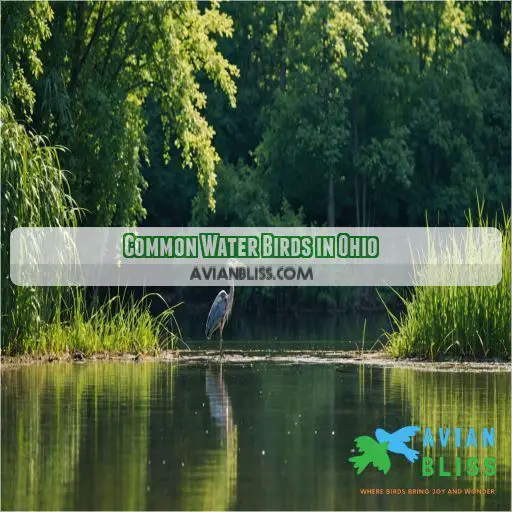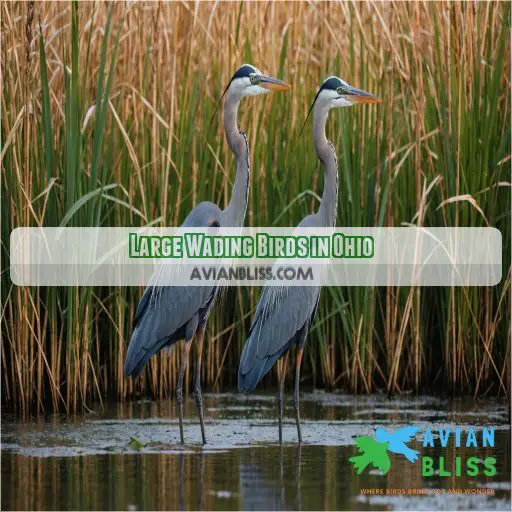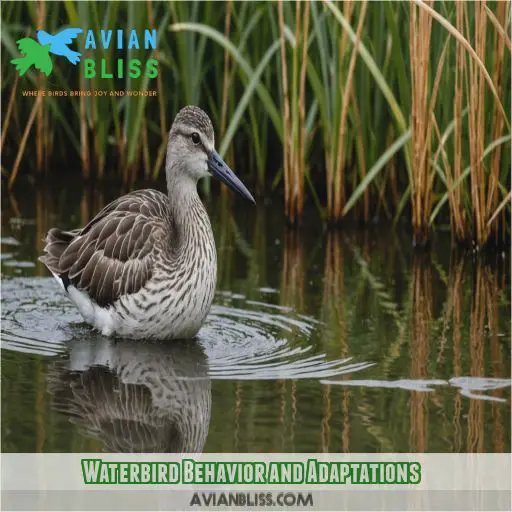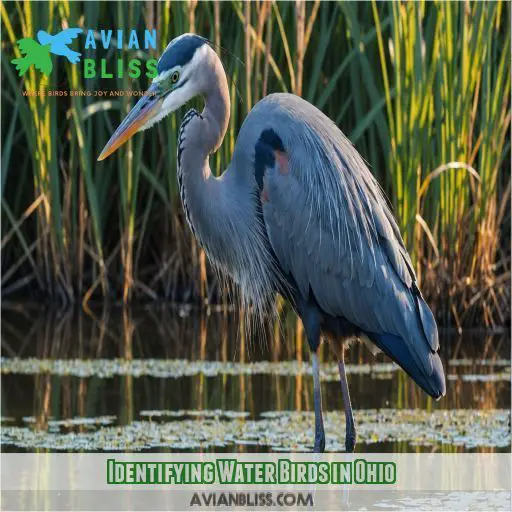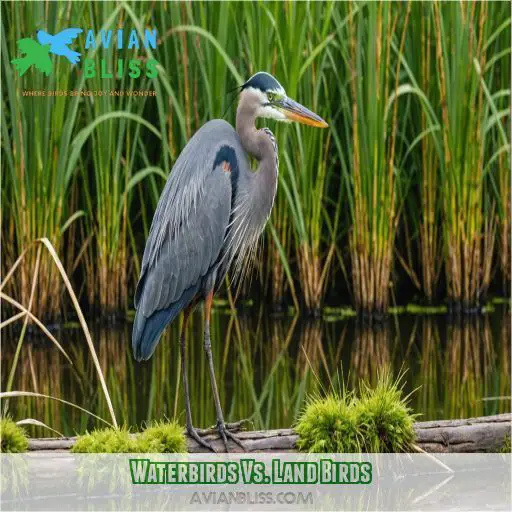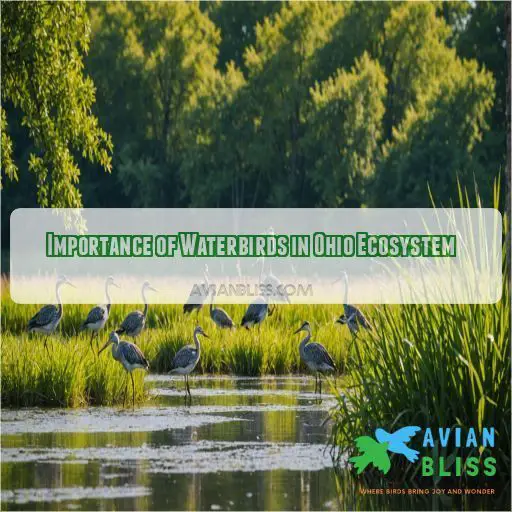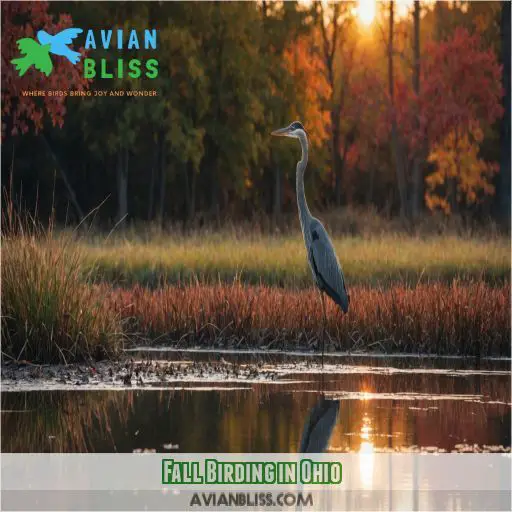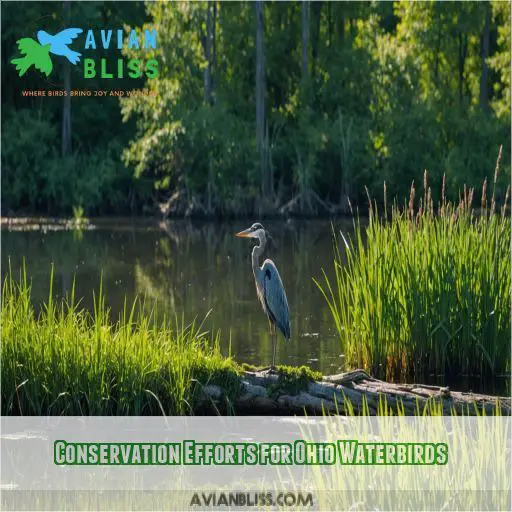This site is supported by our readers. We may earn a commission, at no cost to you, if you purchase through links.
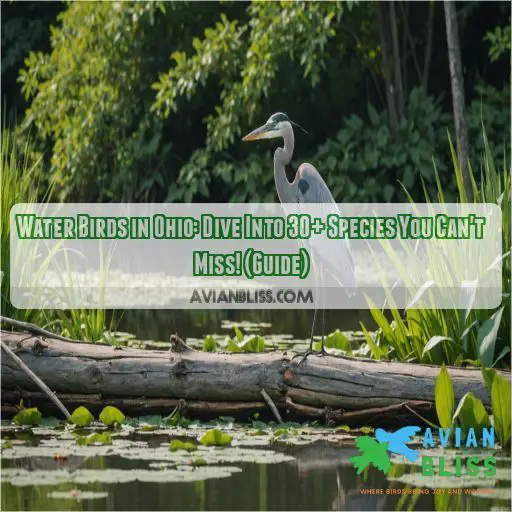
With over 30 species calling the Buckeye State home, you’re in for a treat.
From the familiar Mallard and Canada Goose to the lesser-known American Wigeon and Northern Shoveler, Ohio’s waterways are teeming with feathered friends.
But what makes these birds so unique?
For starters, their adaptations to Ohio’s wetlands are simply remarkable.
Want to know more about the fascinating world of water birds in Ohio, including the best places to spot them and expert tips for identification?
The journey’s just beginning!
Table Of Contents
- Key Takeaways
- Common Water Birds in Ohio
- Large Wading Birds in Ohio
- Waterbird Behavior and Adaptations
- Best Places to Spot Water Birds in Ohio
- Identifying Water Birds in Ohio
- Common Loons in Ohio
- Waterbirds Vs. Land Birds
- Importance of Waterbirds in Ohio Ecosystem
- Fall Birding in Ohio
- Conservation Efforts for Ohio Waterbirds
- Frequently Asked Questions (FAQs)
- What are the big wading birds in Ohio?
- What is the common water bird?
- Are there common loons in Ohio?
- Which birds stay around water?
- What time of day are water birds most active?
- How do water birds survive harsh Ohio winters?
- Can I feed water birds in my backyard?
- Are water birds affected by pollution in Ohio lakes?
- Can I have a water bird as a pet in Ohio?
- Conclusion
Key Takeaways
- You’ll be amazed by the diversity of water birds in Ohio, with over 30 species to spot. You’ll want to grab your binoculars and hit the wetlands to catch a glimpse of these feathered friends in action.
- To identify water birds, pay attention to distinctive physical characteristics like beak shapes, plumage patterns, and leg and foot adaptations. These traits will help you pinpoint a species and make the most of your birding adventure.
- Water birds play a crucial role in Ohio’s ecosystem, controlling insect populations, serving as a food source for other animals, and maintaining nutrient cycles. By supporting waterbird populations, you’re helping to maintain a healthy balance in the state’s natural world.
- To spot water birds in Ohio, head to shallow-water wetlands like Battelle-Darby Metro Park and Pickerington Ponds. Be sure to visit during late afternoon or evening when these birds are most active. Don’t let the weather stop you – just grab your rain gear and get ready for some fantastic birding opportunities.
Common Water Birds in Ohio
You’re in for a treat as we explore Ohio’s diverse water bird population. From the iconic Mallard to the striking Wood Duck, you’ll discover a vibrant array of feathered friends that call Ohio’s waters home.
Mallard
You’ll spot Mallards everywhere in Ohio’s wetlands. These common ducks are easy to identify:
- Males: green heads, white collars, yellow bills
- Females: mottled brown, orange-brown bills
- Both: purple-blue wing patches
- Quack-tastic personalities!
They’re like the friendly neighbors of the duck world, always up for a chat and a snack. Watch them dabble for food or take off with a splash. They’re nature’s ultimate multitaskers!
Canada Goose
You can’t miss the Canada Goose in Ohio! These large birds are hard to overlook with their long black necks and distinctive white cheek patches, like those found on the iconic Toco Toucan.
They’re right at home around human development, so you’ll often spot them waddling across parks or swimming in local ponds.
Keep an eye out for their V-shaped flight formations during migration seasons.
They’re a perfect example of how wildlife adapts to urban environments.
American Wigeon
You’ll love spotting American Wigeons in Ohio! These compact water birds are real head-turners. Here’s what to look for:
- Males: Brown body, green band behind eyes, white crown
- Females: Brown overall, grayer head
- Both: Blue-gray bills with black tips
Wigeons are like the social butterflies of the duck world. They’re often seen in mixed flocks, chatting it up with other waterfowl. Keep your eyes peeled for these charming visitors during migration seasons!
Northern Pintail
You’ll be charmed by the elegant Northern Pintail, a slender duck with a long neck and tail.
Males sport a cinnamon-brown head and white throat, while females rock a more subtle tan look.
These graceful flyers love shallow wetlands and often tip up to feed on aquatic plants.
Keep an eye out for their distinctive silhouette during spring and fall migrations across Ohio’s waterways.
Northern Shoveler
You’ll spot these characters by their massive, spoon-shaped bills – perfect for sifting through muddy waters for tasty morsels.
Males rock a flashy green head and reddish-brown flanks, while females keep it low-key with brown feathers.
Both sexes sport a distinctive blue shoulder patch.
These unique ducks are a real treat for birdwatchers in Ohio’s wetlands!
Redhead
You’ll love spotting Redheads in Ohio’s waters! These charming ducks are easy to identify with their:
- Steep foreheads
- Black-tipped gray bills
- Distinctive cinnamon-red heads (males)
Males sport yellow eyes and gray bodies with black chests, while females are brownish with paler faces. They’re like the stylish cousins of the duck world, turning heads wherever they swim. Keep an eye out for these beauties during their migration through Ohio!
Common Goldeneye
Moving on from the Redhead, let’s explore another fascinating diving duck: the Common Goldeneye. You’ll easily spot these striking birds with their distinctive features. Males have a dark green head, bright yellow eye, and a telltale white cheek patch. The body? Mostly white, with a black back and rump. Ladies rock a brown head, short dark bill with a yellow tip, and pale yellow eyes.
| Feature | Male | Female |
|---|---|---|
| Head | Dark green | Brown |
| Eye | Bright yellow | Pale yellow |
| Body | White, black back | Grayish-brown |
Red-breasted Merganser
You’ll love spotting the Red-breasted Merganser in Ohio’s waters.
These slim ducks have long bodies, necks, and thin bills.
Breeding males sport a dark green head with a spiky crest, cinnamon chest, and red eyes.
Females and non-breeding males are greyish-brown.
Keep an eye out for their distinctive silhouette as they skim the water’s surface, diving for fish.
They’re a real treat for birdwatchers!
Gadwall
You’ll love spotting the Gadwall, a subtle beauty among Ohio’s water birds. These ducks sport an intricate pattern of gray, brown, and black feathers. Males rock a brown head and dark bill, while females are mottled shades of brown. Here’s what to look for:
- Elegant gray body with scalloped patterns
- Distinctive white patch on the rear flanks
- Slender neck and small head
- Swift, graceful flight with rapid wingbeats
Gadwalls prefer shallow wetlands, so keep your eyes peeled next time you’re out birdwatching!
Blue-winged Teal
Moving on from the Gadwall, let’s talk about the Blue-winged Teal. You’ll love these little ducks! The males sport a bluish head with a white band in front of the eye, while females are mottled brown. They’re social butterflies, often seen in flocks. Here’s a quick comparison:
| Feature | Male | Female |
|---|---|---|
| Head | Blue | Brown |
| Bill | Black | Dark |
| Body | Brown | Brown |
Keep your eyes peeled for these charming water birds in Ohio’s wetlands!
Green-winged Teal
Moving on from the Blue-winged Teal, let’s chat about its smaller cousin, the Green-winged Teal.
These pint-sized ducks are real head-turners!
Males sport chestnut-brown heads with a dashing green ear patch, while females rock a mottled brown look.
Both sexes flaunt a green wing patch, their signature style.
Keep your eyes peeled for their quick, darting flight as they zip across Ohio’s wetlands.
Wood Duck
You’ll be hard-pressed to find a more eye-catching bird than the Wood Duck. These colorful characters are real head-turners with their intricate plumage. Males sport a green crested head, red eyes, and chestnut breast with white flecks. Females keep it low-key with brown bodies and grayish heads. Here’s what makes Wood Ducks stand out:
- They’re tree-huggers, nesting in cavities high above the ground
- They’ve got built-in crampons, with sharp claws for gripping bark
- These ducks are regular Houdinis, able to squeeze through tiny openings
Bufflehead
Moving on from the intricate Wood Duck, let’s talk about the charming Bufflehead. These small ducks are a sight to behold with their large heads and compact bodies. You’ll spot them bobbing on Ohio’s waters like little buoys. Here’s a quick rundown of what you need to know:
| Feature | Male | Female |
|---|---|---|
| Head | Large white patch | Dark, slightly crested |
| Body | White chest & flanks | Mostly brownish |
| Back | Dark, iridescent | Dark |
| Bill | Short, gray | Short, gray |
| Eyes | Dark | Dark |
Hooded Merganser
Continuing our journey through Ohio’s water birds, let’s meet the charming Hooded Merganser. This small duck with a long, slender bill is a real head-turner, especially during breeding season. You’ll be amazed by the male’s striking appearance:
- A large, fan-shaped crest with a white patch
- Yellow eyes that seem to glow
- A mostly black body with chestnut flanks
Females sport a cinnamon-colored crest and overall brown plumage. Keep your eyes peeled for these beauties near wooded ponds and rivers!
Common Merganser
You’ll love spotting the Common Merganser in Ohio’s waters. These striking ducks are real head-turners, especially during breeding season. Let’s break down what makes these birds so special:
| Feature | Male | Female |
|---|---|---|
| Head | Mallard-like green | Cinnamon-colored |
| Body | Mostly white | Grayish-white |
| Bill | Long, slender, orange | Long, slender, orange |
| Eyes | Dark | Dark |
| Behavior | Excellent diver | Excellent diver |
Keep an eye out for these fish-eating experts on your next birding adventure!
Large Wading Birds in Ohio
You’ll find some impressive wading birds in Ohio’s wetlands and waterways. From the majestic Great Blue Heron to the secretive American Bittern, these large water birds add drama and intrigue to the state’s aquatic habitats.
Great Blue Heron
You’ll often spot the majestic Great Blue Heron along Ohio’s waterways.
These tall, lanky birds are hard to miss with their S-shaped necks and long legs.
They’re patient hunters, standing still as statues in shallow water, waiting to snag fish or frogs.
Come breeding season, they gather in noisy colonies called heronries.
Keep your eyes peeled for their slow, graceful flight over lakes and rivers!
American Bittern
Moving from the majestic Great Blue Heron, let’s turn our attention to its secretive cousin, the American Bittern.
You’ll need a keen eye to spot this master of camouflage!
With its buffy brown plumage and streaked underparts, it’s perfectly suited for blending into wetland vegetation.
These medium-sized water birds are a treat to observe, but you’ll need patience and a bit of luck to catch a glimpse of their stealthy movements.
Green Heron
You’re in for a treat with the Green Heron! This small but mighty wader is a master of disguise. You’ll spot them lurking near Ohio’s wetlands, often with their necks tucked in tight. Here’s what to look for:
- Dagger-like bill, perfect for spearing fish
- Chestnut-brown neck and belly
- Green-black cap and back
- Short, stocky build that’s easy to miss
These clever birds are known for their fishing skills – they’ve even been seen using bait to lure in prey!
Great Egret
You’re in for a treat when you spot a Great Egret in Ohio’s wetlands!
These stunning water birds are hard to miss with their snow-white plumage and long, S-shaped necks.
During breeding season, they’ll wow you with their fancy feathery plumes called aigrettes.
Keep your eyes peeled near shallow waters, where they’ll be stalking fish, frogs, and other tasty morsels with their sharp, dagger-like bills.
Black-crowned Night Heron
You’ll love spotting the Black-crowned Night Heron in Ohio’s wetlands. These compact birds are nature’s night owls, often active when other birds are tucked in. Here’s what makes them stand out:
- Hunchbacked appearance
- Black cap and back contrasting with white belly
- Thick, dagger-like bill
They’re masters of stealth, quietly stalking fish and frogs. Watch for them perched motionlessly near water’s edge, waiting for the perfect moment to strike. Their unique looks and nocturnal habits make them a birder’s delight!
Waterbird Behavior and Adaptations
You’ll be amazed at how waterbirds in Ohio thrive in all sorts of weather conditions. These feathered marvels have some nifty tricks up their wings, from unique feeding schedules to impressive migration patterns, that’ll make you see them in a whole new light.
Feeding Schedules
You’ll find waterbirds don’t follow the same feeding schedule as their land-dwelling cousins.
These feathered swimmers often chow down throughout the day, adapting to tides and light conditions.
Some, like shorebirds, time their meals with low tide, while others might feed at dusk or dawn.
Their diverse diets and feeding behaviors make Ohio’s waterways a bustling buffet from sunrise to sunset!
Tolerance to Weather Conditions
Unlike their land-dwelling cousins, water birds don’t let the weather rain on their parade. They’re tough as nails when it comes to braving the elements. Here’s why these feathered friends are the ultimate all-weather warriors:
- Cold-proof plumage: Their waterproof feathers keep them toasty even in icy waters.
- Built-in rain gear: Water rolls right off their backs, literally!
- Night vision: Many species can feed in low light or complete darkness.
Tactile Feeding
Ever wonder how waterbirds find food in murky waters?
It’s all about tactile feeding!
These clever birds use their sensitive beaks to feel for prey, even in low light.
Their specialized bills are like built-in metal detectors, helping them locate tasty morsels hidden in mud or water.
From probing shorebirds to dabbling ducks, each species has unique adaptations for this hands-on (or should we say beaks-on?) dining approach.
Migration Patterns
You’re now familiar with tactile feeding, let’s explore migration patterns. Waterbirds migrate to find suitable breeding and feeding grounds. Here are some key aspects of their migration:
- Migration timing: Different species migrate at different times, depending on factors like food availability and weather.
- Flyways: Waterbirds use established routes, like the Atlantic Flyway, to migrate between breeding and wintering grounds.
- Wintering grounds: Many waterbirds spend the winter in warmer regions, like the southern United States or Central America.
- Breeding grounds: Waterbirds return to their breeding grounds in the spring, often traveling long distances to reach their desired location.
- Migration routes: Some waterbirds migrate alone, while others travel in large flocks, following the same routes year after year.
Importance of Tidal Cycles
You’re exploring Ohio’s coast, and you wonder why shorebirds seem to appear and disappear with the tides. It’s because tidal cycles play a big part in their migration and feeding strategies. As the tide recedes, shorebirds swoop in to feast on exposed food sources in tide pools and coastal habitats, like those found in Summit Metro Parks.
Best Places to Spot Water Birds in Ohio
You’re ready to spot some water birds in Ohio, but where do you start? From shallow-water wetlands to man-made parks like Battelle-Darby Metro Park and Pickerington Ponds, we’ve got the inside scoop on the best places to catch a glimpse of these amazing creatures.
Shallow-water Wetlands
You’re in luck! Shallow-water wetlands are a haven for water birds in Ohio. Here are four reasons why:
- Diverse bird species: Expect to spot a wide range of water birds, from herons to ducks.
- Abundant plant life: Wetlands support a variety of aquatic plants, attracting birds and other wildlife.
- Prime migratory stopovers: Many water birds migrate through Ohio’s wetlands, making them a great spot for birding.
- Improved water quality: Wetland restoration efforts have enhanced water quality, benefiting both birds and humans.
Man-made Wetlands
You’re in luck! Ohio has plenty of man-made wetlands that are perfect for spotting water birds, much like the vibrant herons and spoonbills found in Florida’s wetlands.
. These wetlands offer a unique opportunity to observe birds in a controlled environment. Check out the benefits and challenges of man-made wetlands below:
| Wetland Benefits | Wetland Challenges | Wetland Management |
|---|---|---|
| Habitat creation | Invasive species | Water level control |
| Biodiversity increase | Pollution | Vegetation management |
| Birdwatching opportunities | Climate change | Restoration efforts |
Visit these man-made wetlands to spot your favorite water birds!
Battelle-Darby Metro Park
A birder’s paradise, Battelle-Darby Metro Park offers:
- 7,000 feet of boardwalks and trails through wetland habitats.
- The park attracts migratory birds and provides great birdwatching opportunities.
- Keep an eye out for herons, egrets, and waterfowl.
- This park is a must-visit for bird enthusiasts in Ohio.
Pickerington Ponds
At Pickerington Ponds, you’ll spot water birds thriving in their natural habitat. This man-made wetland is a haven for birdwatching, with over 400 acres of ponds, marshes, and forests. Look for waterfowl like American Coots, Great Blue Herons, and Wood Ducks. Conservation efforts are in place to protect this habitat, making it a must-visit for nature enthusiasts.
Three Creeks
At Three Creeks, you’ll discover a haven for water birds. This restored wetland offers a diverse range of habitats, attracting wintering birds and waterfowl. As you explore, keep an eye out for American Wigeons, Northern Pintails, and Gadwalls. Conservation efforts have made this spot a gem for birding, with over 200 species documented. Come and experience it for yourself!
Hoover Nature Preserve
At Hoover Nature Preserve, you’ll discover a haven for water birds. As you wander through the wetlands, keep an eye out for:
- American Coots swimming in the shallows
- Great Blue Herons wading through the marshes
- Wood Ducks paddling through the ponds
- Canada Geese flying overhead in V-formation
Come during fall migration for the best birdwatching experience.
Taylor Farms Park
At Taylor Farms Park, you’ll discover a haven for water birds. Explore the park’s trails, and you might spot a Mallard or American Wigeon. Visit during early morning or late afternoon for the best sightings. Don’t miss the park’s activities, like birding walks and nature talks.
| Water Bird Species | Best Time to Visit |
|---|---|
| Mallard | Early morning |
| American Wigeon | Late afternoon |
| Canada Goose | Spring migration |
| Wood Duck | Summer months |
| Great Blue Heron | Year-round |
Identifying Water Birds in Ohio
You’re ready to get up close and personal with Ohio’s amazing water birds, but first, you need to know who’s who.
Let’s explore the fascinating world of water bird identification.
From distinctive plumage patterns to beak shapes and sizes, you’ll be well on your way to becoming a water bird expert and making the most of your next birding adventure in Ohio.
Physical Characteristics
When identifying water birds in Ohio, take note of their physical characteristics. Look for distinct beak shapes, like the Northern Shoveler’s large, wide bill or the Common Merganser’s long, slender bill. Body size and wing patterns can also be telling, as can foot adaptations, such as the American Coot’s lobed toes. These traits can help you pinpoint a species.
Plumage Patterns
When identifying water birds in Ohio, pay attention to plumage patterns. Note the colors, shapes, and arrangements of feathers. Seasonal changes can affect plumage, so consider the time of year. Color significance can also provide clues, like the distinctive green head of a Mallard. Look for unique patterns, like the intricate designs on a Wood Duck’s feathers.
Beak Shapes and Sizes
Now that you’re familiar with plumage patterns, let’s talk beaks!
Beak shapes and sizes are really important for identifying water birds in Ohio.
Different species have evolved unique beak adaptations to suit their feeding strategies.
For example, the Northern Shoveler’s large, wide bill is perfect for scooping up tiny crustaceans, while the Green Heron’s long, dagger-like bill is ideal for catching fish.
Leg and Foot Characteristics
Now that you’ve got a handle on beak shapes and sizes, let’s wade into leg and foot characteristics. You’ll notice that water birds have some amazing adaptations that help them thrive in their environments. Here are three key things to look for:
- Webbed feet: Perfect for paddling and diving, these feet are a hallmark of ducks, geese, and mergansers.
- Lobe feet: With their unique, lobed toes, coots and grebes are able to grasp and maneuver aquatic plants.
- Leg length and foot size: Herons and egrets have long legs and large feet, ideal for wading and snatching fish from the water.
Common Loons in Ohio
You’re likely to spot Common Loons in Ohio’s larger lakes and reservoirs, where they can be seen swimming low in the water, their distinctive black and white feathers a striking sight. As you learn more about these amazing birds, you’ll discover their unique characteristics, habits, and habitats, and maybe even catch a glimpse of their hauntingly beautiful calls.
Habitat and Distribution
You’re ready to explore the habitat and distribution of Common Loons in Ohio. These waterbirds thrive in aquatic environments, particularly in Lake Erie and surrounding wetlands. Here’s a snapshot of their habitat and distribution:
| Habitat | Distribution |
|---|---|
| Large lakes, reservoirs | Lake Erie, Ohio River |
| Wetlands, marshes | Northern Ohio, coastal areas |
| Aquatic vegetation | Eastern Ohio, Appalachian region |
| Rocky shorelines | Islands, shoreline areas |
Keep in mind that habitat change and distribution patterns can impact Common Loon populations, making conservation efforts really important.
Feeding Habits
Common Loons in Ohio are expert divers when it comes to feeding habits.
They catch fish, crayfish, and frogs in the water.
Their diet changes seasonally, with more fish in the summer and crustaceans in the winter.
They’re also adaptive feeders, adjusting their strategy to suit the environment.
Breeding and Nesting
You’re interested in learning about Common Loons’ breeding and nesting habits in Ohio. During breeding season, which typically occurs from April to July, loons choose nesting sites with dense vegetation and proximity to water. They construct nests using aquatic plants, mud, and rocks. Female loons lay 1-2 eggs, which both parents take turns incubating and caring for.
Waterbirds Vs. Land Birds
If you’re ever out exploring Ohio’s lakes and rivers, you might wonder how the birds that call these waters home are different from the ones you see on land. Water birds have some pretty cool tricks up their sleeves, from how they find their meals to how they handle all kinds of weather.
Differences in Behavior
You’re probably curious about the differences in behavior between waterbirds and land birds. One key distinction is their response to weather. While land birds often take a raincheck on foraging during bad weather, waterbirds aren’t deterred. Here are three ways waterbirds adapt to weather conditions:
- Feeding in the rain: Waterbirds continue to forage for food even in rainy or dark conditions.
- Tactile feeding: They use their sense of touch to find food, allowing them to feed in low-light conditions.
- Migration patterns: Waterbirds migrate to find suitable breeding and feeding grounds, often traveling long distances.
Adaptations to Environment
You’re probably wondering how waterbirds adapt to their environment so easily. It’s all about their amazing physical features!
| Waterbirds | Land Birds |
|---|---|
| Waterproof feathers for cold tolerance | Lightweight feathers for flight |
| Strong, webbed feet for swimming | Strong, clawed feet for perching |
| Flexible feeding schedules | Fixed feeding schedules |
These adaptations help waterbirds thrive in Ohio’s diverse water environments.
Feeding Strategies
When it comes to feeding strategies, waterbirds and land birds have different approaches. Waterbirds are tactile feeders, using their sensitive beaks to search for food in low light conditions. They also feed throughout the day, regardless of weather. In contrast, land birds are more active in the morning and tend to rely on visual cues to find food.
Importance of Waterbirds in Ohio Ecosystem
You might be surprised at how important waterbirds are to Ohio’s ecosystem – they play a key role in controlling insect populations and serving as a food source for other animals. By understanding the importance of waterbirds, you’ll gain a deeper appreciation for the intricate balance of Ohio’s natural world and the many ways these birds contribute to it.
Role in Controlling Insect Populations
You mightn’t realize it, but waterbirds play a big role in controlling insect populations in Ohio’s ecosystem. By feeding on insects, they help prevent outbreaks and keep the ecosystem in balance. Here are 4 ways waterbirds impact insect populations:
- Natural pest control: Waterbirds feed on insects, reducing the need for pesticides.
- Ecosystem balance: By controlling insect populations, waterbirds maintain a balanced food web.
- Waterbird diets: Many waterbirds, like herons and egrets, primarily feed on insects.
- Insect outbreak prevention: Waterbirds help prevent insect outbreaks, protecting crops and forests.
Food Source for Other Animals
You mightn’t realize it, but waterbirds play a really important role in Ohio’s ecosystem as a food source for other animals. They’re an essential link in the food chain, supporting predators like hawks, owls, and foxes. Waterbird predation affects the balance of the ecosystem, making conservation efforts important to maintaining a healthy food web dynamics and predator-prey balance.
Nutrient Cycling
You mightn’t realize it, but waterbirds play a really important role in Ohio’s ecosystem through nutrient cycling. As they feed, they transport nutrients from one place to another, influencing water quality and plant growth. This process has a ripple effect, impacting the entire food chain. By supporting waterbird populations, you’re helping maintain a healthy ecosystem.
Ecosystem Balance
You play a big role in maintaining ecosystem balance in Ohio. Waterbirds help regulate water quality, control insect populations, and serve as indicators of environmental health. Here are some ways waterbirds contribute to ecosystem balance:
- Regulate water quality through their feeding habits
- Control insect populations, reducing the need for pesticides
- Serve as indicators of environmental health, signaling issues like pollution and climate change
- Maintain aquatic plant diversity through their foraging activities
- Support nutrient cycling by transporting nutrients between ecosystems
Fall Birding in Ohio
As you head out for fall birding in Ohio, remember that the changing seasons bring new opportunities to spot waterbirds.
Ohio’s wetlands are a great place to start your search.
Whether you’re a seasoned birder or just starting out, Ohio’s fall landscapes offer a chance to see over 30 species of waterbirds, from ducks and geese to herons and egrets, in their natural habitats.
Best Time and Places to Spot Waterbirds
As you explore Ohio’s wetlands during fall migration, you’ll discover a haven for waterbirds. Shallow-water wetlands like Battelle-Darby Metro Park and Pickerington Ponds are ideal spots. Visit during late afternoon or evening when waterbirds are most active.
| Location | Best Time to Visit |
|---|---|
| Battelle-Darby Metro Park | Late Afternoon |
| Pickerington Ponds | Early Evening |
| Hoover Nature Preserve | Late Morning |
| Taylor Farms Park | Mid-Afternoon |
Tips for Birding in Inclement Weather
Don’t let the rain stop you from birding! Grab your rain gear and head out to shallow-water wetlands, where waterbirds are active even in inclement weather. To capture the beauty of water birds in Ohio, it’s essential to have the right bird photography equipment, including a telephoto lens with a focal length of at least 300mm, which you can learn more about in a bird photography equipment checklist. Bring your camera for great bird photography opportunities. Consider setting up bird feeders to attract birds to your yard. Winter birding requires patience, but the rewards are worth it.
Dressing for the Weather
When fall birding in Ohio, don’t let the weather stop you. To stay comfortable and safe, focus on layering and waterproof gear. Here are four essentials to pack:
- Breathable base layers to keep you warm and dry.
- Waterproof jacket and pants to shield you from the elements.
- Insulating mid-layers for added warmth on chilly days.
- Sturdy, waterproof boots for safe and comfortable walking.
Birding Gear and Equipment
When birding in Ohio, the right gear makes all the difference. Here’s a rundown of essentials to get you started:
| Gear | Why You Need It |
|---|---|
| Binoculars | Spot birds from a distance without disturbing them |
| Field Guides | Identify species with confidence |
| Cameras | Capture memories and help with ID |
Dress in layers, and don’t forget a hat and sunscreen!
Conservation Efforts for Ohio Waterbirds
Now that you’re equipped with the know-how to spot these fascinating water birds and the best places to find them, let’s make sure these creatures continue thriving in Ohio for generations to come. Conservation efforts are key to protecting the diverse bird species that call Ohio home, and there are a few key strategies in play:
- Wetland Restoration: Ohio’s wetlands are critical habitats for water birds, providing breeding, migratory, and wintering grounds. Projects like the Western Lake Erie Coastal Project aim to expand and enhance these habitats, benefiting species like scaup, trumpeter swans, and mallards.
- Water Quality Initiatives: Ensuring clean water is essential for water bird health. Efforts to improve water quality in Ohio focus on reducing pollution, maintaining healthy water flows, and restoring natural water cycles, creating safer environments for birds and humans alike.
- Bird Banding and Monitoring: Bird banding is an important tool used by conservationists to track bird movements, survival rates, and population trends. This data helps inform habitat management decisions and identify areas where conservation efforts can make the most impact.
These initiatives are just a few examples of the dedicated work being done to protect Ohio’s water birds and their habitats.
Frequently Asked Questions (FAQs)
What are the big wading birds in Ohio?
You’re likely thinking of herons and egrets! For example, the Great Blue Heron is a common sight in wetlands, with its majestic S-shaped neck and stealthy hunting style. Look for these big waders in shallow waters.
What is the common water bird?
You’re probably thinking of the Mallard – it’s one of the most common water birds around! Males have a bright green head, yellow bill, and black rump, while females are mottled brown with an orange bill.
Are there common loons in Ohio?
You’re on the lookout for Common Loons in Ohio? Yes, they can be spotted in the state, particularly during migration periods. Keep an eye out for their distinctive black and white checkerboard backs and haunting calls.
Which birds stay around water?
You’ll spot herons, egrets, and ibises near water, as they hunt for fish and frogs. Ducks, geese, and swans also call water home, along with loons, grebes, and cormorants – all adapted to thrive in aquatic environments.
What time of day are water birds most active?
Unlike early-rising land birds, water birds don’t follow a traditional morning schedule. Instead, they’re active throughout the day, feeding in short intervals, regardless of the weather, so you can spot them at any time.
How do water birds survive harsh Ohio winters?
You’re wondering how water birds survive harsh winters? They’ve got clever adaptations, like waterproof feathers and a high metabolism, to keep them warm and cozy. Plus, many migrate to warmer spots or find food in icy waters.
Can I feed water birds in my backyard?
Want to make some feathered friends? Feeding water birds in your backyard can be a delightful way to connect with nature, but be sure to use the right foods and follow local guidelines to keep them healthy and happy.
Are water birds affected by pollution in Ohio lakes?
You’re right to worry about pollution‘s impact on water birds. Chemical contaminants, like pesticides and heavy metals, can harm them, while plastic waste and algal blooms threaten their habitats and food sources.
Can I have a water bird as a pet in Ohio?
You’re keen on a water bird as a pet, but it’s not that simple in Ohio. One person’s story shows the challenges. They wanted ducks, but permits are needed for wild-caught birds. Pet shops sell mallards, but permits and markings are needed if you plan to sell or release them.
Conclusion
As the saying goes, "the early bird catches the worm," but in Ohio, the keen observer catches the water bird!
With over 30 species to spot, you’re now equipped to get started in the wonderful world of water birds in Ohio.
From adaptations to identification tips, you’ve got the inside scoop.

